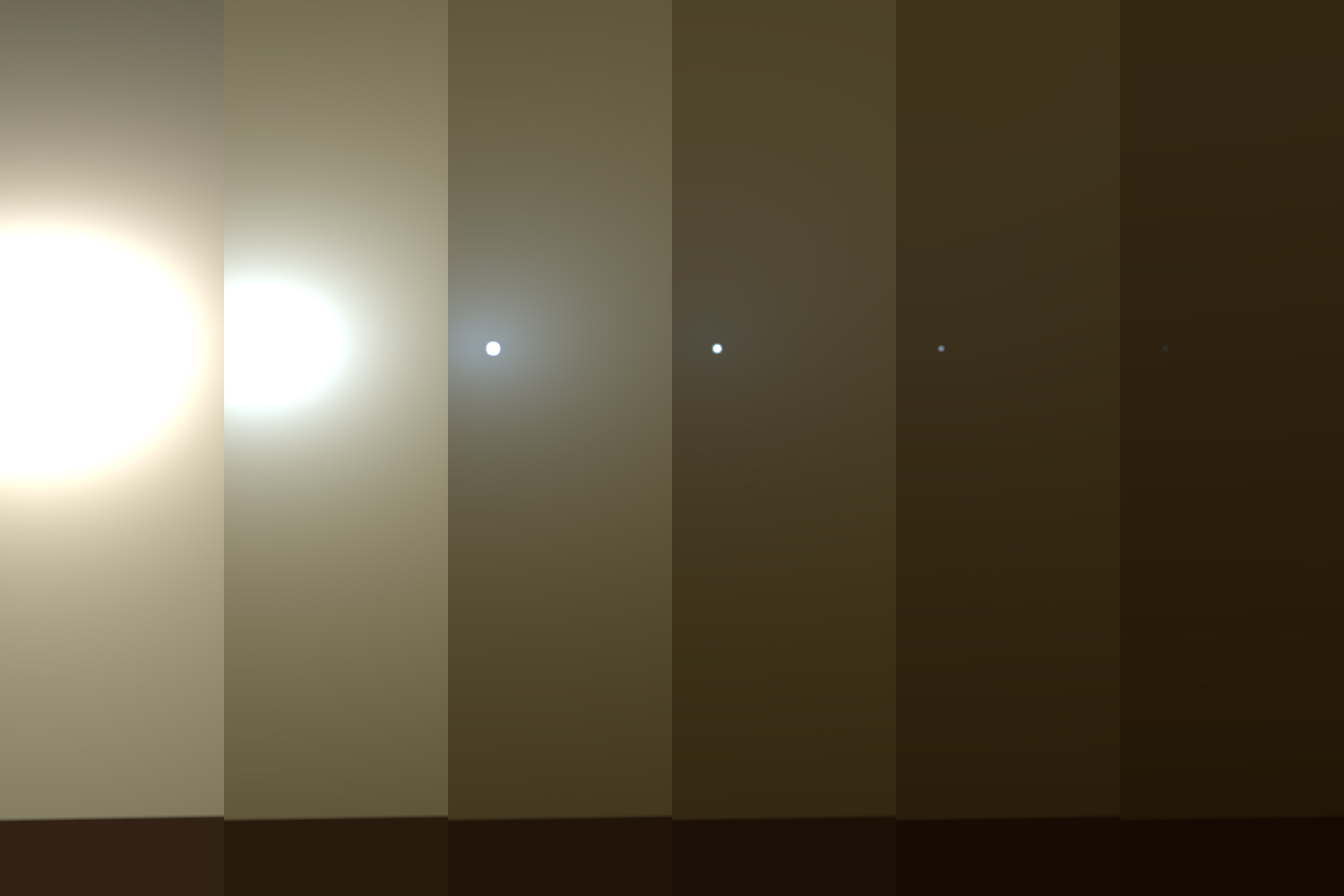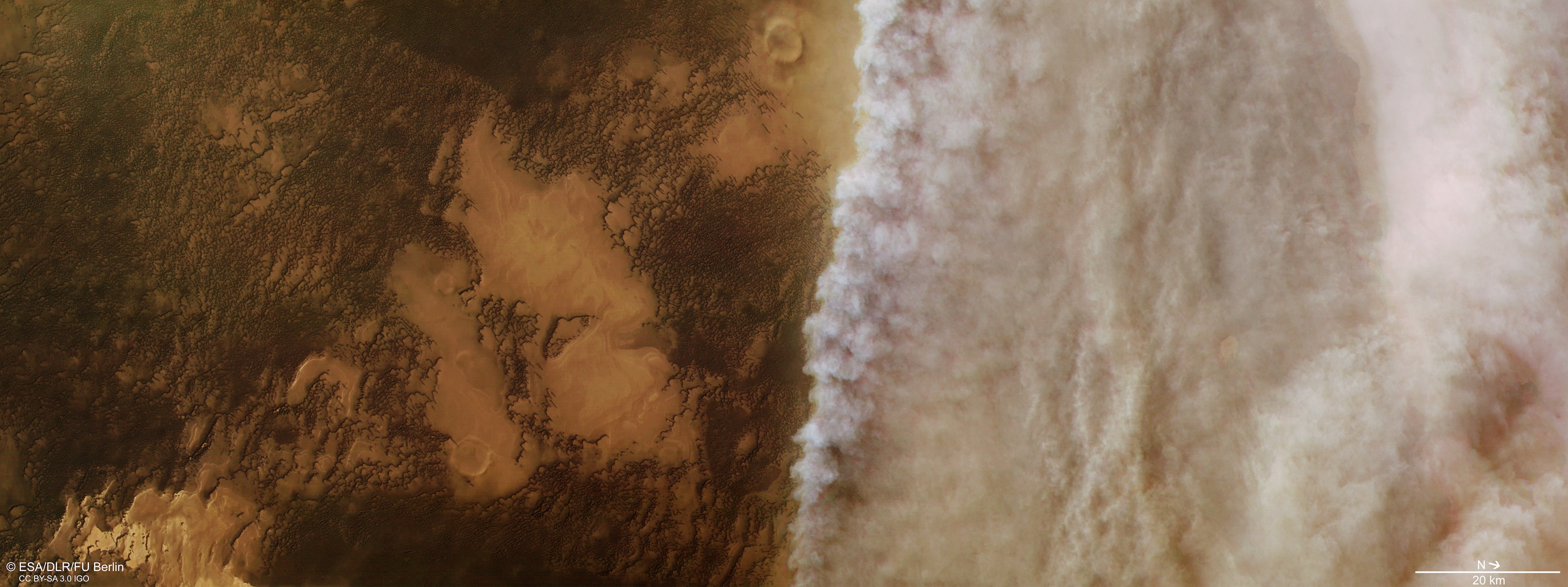Gravity Assist Podcast: Mars Dust Storm with Melinda Kahre

The Gravity Assist Podcast is hosted by NASA's Chief Scientist, Jim Green, who talks to some of the greatest planetary scientists on the planet, giving a guided tour through the Solar System and beyond in the process. This week, he's joined by Melinda Kahre, who manages the Mars Climate Modeling Center at NASA's Ames Research Center and is an expert in Martian dust storms.
You can listen to the full podcast here, or read the abridged transcript below. [See How Huge the Monster Dust Storm on Mars Is in This Stunning Image]
Jim Green: What is the Mars Climate Modeling Center and how does it work?
Melinda Kahre: The Mars Climate Modeling Center is a group here at NASA Ames that develops global climate codes to simulate the weather and climate on Mars. We need large computing power to be able to run our simulations, so we need the supercomputer at NASA Ames.
Jim Green: To accurately see what's happening on Mars using your codes, you need input data. We have data from several orbiters and of course we've got weather stations on our rovers and landers on Mars. What's the most important datasets that you have to ingest into the models?
Melinda Kahre: We use data in a variety of ways for numerical modeling. Some datasets we use directly in the model — the observed topography of Mars is a good example of that — and some datasets we use to compare with model results, to understand how realistic our datasets are. One really good example of that is the maps of atmospheric dust that are coming back from the orbiters.
Jim Green: What are some of the parameters that are important in making these models work?
Breaking space news, the latest updates on rocket launches, skywatching events and more!
Melinda Kahre: [The parameters are] everything that makes the climate of Mars run — so there are dynamical processes and physical processes. On the dynamical side we have winds, temperatures, pressures and densities, and on the physical side we represent processes like dust lifting, cloud formation, radiative transfer, how radiation affects the temperatures in the atmosphere and things like that.
Jim Green: How do you make all that work?
Melinda Kahre: We really do it piecemeal. We look at one little bit at a time and develop each little section individually.
Jim Green: This summer there's been a huge dust storm in Mars. How often do dust storms go global like that?
Melinda Kahre: Not that often. The last global dust storm was in 2007, so 11 years ago on Earth but six Martian years ago. Generally we see global storms on Mars one out of every three years, but it's been a while since we've seen one this big.
Jim Green: In 2007 Curiosity [rover] hadn't landed, but Spirit and Opportunity were going strong and managed to survive that global dust storm.
Melinda Kahre: Yes they did, both of them, and they observed the amount of dust in the atmosphere throughout that storm.
Jim Green: What's the composition of the dust?
Melinda Kahre: The dust grains are mostly silicates, so plagioclase, feldspars, zeolite, and they also have some iron oxides, which is why they look a little bit red.
Jim Green: How big are they? Are they like grains of sand on a beach?
Melinda Kahre: They're smaller than sand. We're talking one and a half microns, two microns, so think of them as like really fine ash in size.
Jim Green: The dust is really small and then can be lofted [into the atmosphere] but there's also dust that's slightly larger and gets lofted a little bit but then comes down, so there's a certain way that dust moves over the planet. Can you describe a little bit how that happens?
Melinda Kahre: There are a few different ways that particles move depending on their size. If a particle is really fine like a dust grain that can be lofted directly into the atmosphere then it can enter into suspension, which means that it can blow around without coming back down to the ground too quickly. If the particles are a bit bigger than that, you start talking about sand-sized particles, 100 microns or so, and those particles will leave the ground but they won't get very far before in the air before they fall back down due to gravity. When those particles come back they can then hit the ground and splash other, smaller particles into the air and into suspension.
The final process is called 'creep', which involves large particles that don't really leave the ground but which can roll and bump along the surface a little bit. We think that saltation actually is the most likely mechanism for injecting dust into the atmosphere.
Jim Green: That's when they leave the ground and come back and and throw more particles up, sort of like a cascade.
Melinda Kahre: Yes, it focusses on sand-sized particles because it turns out that those are the easiest particles to move. If particles are too big they don't leave the ground because of gravity, but if they're too small then they stick together on the ground and they're hard to get off the ground. So sand moves most easily and then it can come back down and splash small particles up [into the atmosphere]. [Wake Up, Opportunity! Engineers Have an Awesome Playlist for NASA's Sleeping Mars Rover]
Jim Green: How high can these dust storms get?
Melinda Kahre: We see direct evidence of dust getting up to 60 kilometers or more.
Jim Green: Once the dust particles get lofted into the atmosphere, the dynamics in the atmosphere change, too. What's the biggest thing that happens to the atmosphere during a dust storm?
Melinda Kahre: When you put these small dust particles into the atmosphere they absorb solar radiation and warm the atmosphere. They then radiate in the infrared so the atmosphere actually warms up. The middle of the atmosphere warms, and that warming causes changes to the dynamics, to the wind fields, and the circulation is generally ramped up when you put a lot of dust into the atmosphere. The diurnal cycle [i.e. the day/night temperature difference] is suppressed because when you put dust into the atmosphere it absorbs solar radiation during the daytime, so not as much sunlight comes down to the ground to warm the surface. So the daytime temperatures are cooler with dust in the atmosphere, but then at night those dust particles are radiating in the infrared down to the surface and the surface is actually warmed during the night.
Jim Green: Where is the dust coming from on Mars? Are there specific places where they start?
Melinda Kahre: Dust storms are observed to start in a lot of different locations on Mars. Not every global storm starts in the same place, although a lot of them start in the southern hemisphere. This current dust storm started in the north and traveled across the equator. We don't actually have a great handle on where the surface dust actually is on Mars. We have good indications that there are dusty locations near the equator that have thick dust deposits. We also know that there's a fair amount of dust in the polar regions.
Jim Green: Mars has a fairly elliptical orbit, and my understanding is that the dust storms start when the Sun and Mars are the closest.
Melinda Kahre: That's right, Mars is closest to the Sun near the southern summer solstice, and that tends to be when the circulation is the strongest to begin with.
Jim Green: So that's kind of the season Mars is entering into right now in the southern hemisphere.
Melinda Kahre: That's right.
Jim Green: How long do these global dust storms last? What can we expect to happen next?
Melinda Kahre: They last months. It takes a while for them to get going but once they reach their peak and dust is literally enshrouding the whole planet, we seem to see the lifting centers [i.e. primary deposits of dust that is lifted into the atmosphere] stop operating and then dust falls out slowly over time, and it can take months for that dust to come back down. [What Would It Be Like to Live on Mars?]
Jim Green: This particular dust storm has reached its peak and is maybe waning, so we are still going to have several more weeks of this dust.
Melinda Kahre: Yes, it's going to be up there for a while. The large particles will fall first, and then the small particles will fall out more slowly.
Jim Green: Some people have noticed that Mars looks a little more yellow at night when they look up from Earth and see it — it's not as red at it used to be. Is that because of the dust storm?
Melinda Kahre: Yes, you can't really see the surface of Mars right now when you look at it through a telescope. The whole atmosphere is full of dust that does change the color a little bit.
Jim Green: Does anything like this happen on Earth? I don't know that we expect global dust storms, but some of the physics must be the same.
Melinda Kahre: We don't experience global dust storms here on Earth, but we do have dust storms on Earth and dust devils on Earth, and the physics is the same. We use what we learn from Earth and apply it to other places and that's exactly how we attempt to understand how these things operate on Mars.
Jim Green: One of the things that I always do, because I'm fascinated about how each and every one of us got into the field of science that we're doing, is ask about what event happened in our life that really propelled us forward to become the scientist that we are today. And I call that a 'Gravity Assist'. So, Melinda, what was your gravity assist?
Melinda Kahre: It's actually hard for me to identify just one because I feel I've had lots over the years. I got hooked on science in school when I was pretty young, probably in sixth or seventh grade. I took Earth science and physics and I loved science, I liked the process of science. Then I started taking an astronomy class in college and got hooked on astronomy and then I moved on into planetary science when I went to grad school. Actually the 2001 global storm happened during the summer that I started grad school, and that, among other reasons, was a why I got interested in studying Mars.
This story was provided by Astrobiology Magazine, a web-based publication sponsored by the NASA astrobiology program. This version of the story published on Space.com. Follow us @Spacedotcom, Facebook or Google+.

The National Aeronautics and Space Administration (NASA) is the U.S. government agency in charge of the civilian space program as well as aeronautics and aerospace research. Founded in 1958, NASA is a civilian space agency aimed at exploring the universe with space telescopes, satellites, robotic spacecraft, astronauts and more. The space agency has 10 major centers based across the U.S. and launches robotic and crewed missions from the Kennedy Space Center in Cape Canaveral Florida. Its astronaut corps is based at the Johnson Space Center in Houston. To follow NASA's latest mission, follow the space agency on Twitter or any other social channel, visit: nasa.gov.




